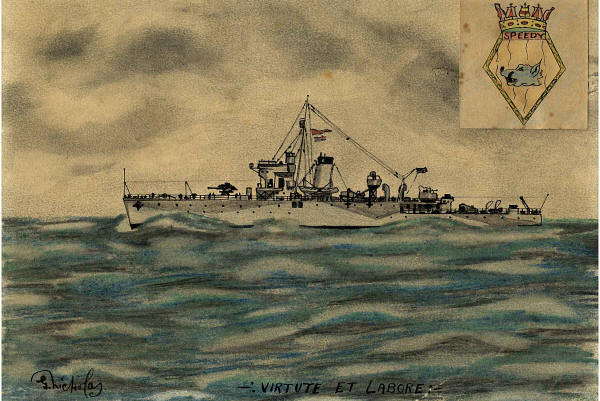HMS SPEEDY (J17) was completed in April 1939.
At the outbreak of the Second World War she was at Scapa with the Home
Fleet, and was employed in home and northern waters during the first two and
a half years of hostilities. In October 1941, she assisted in escorting one
of the first convoys (PQ2) to Archangel, North Russia. The convoy arrived
without loss. Based in Murmansk, she then took part in various minesweeping
and anti-submarine operations in North Russian waters until January 1942. On
the night of 17 December 1941, while engaged on an anti‑submarine sweep in
company with HAZARD she was attacked by four large German destroyers
(Z23, Z24, Z25 and Z27) 14 miles North‑by‑East of Cape Gorodetski.
Although hit, she managed to make off in poor visibility. SPEEDY arrived at
Scapa on 14 January 1942, proceeding thereafter for repairs and a refit in a
London shipyard. In April, she escorted another Russian convoy (PQ14), but
on the 12th was damaged by ice and was repaired at Immingham.
Her next
service was escorting an important Malta convoy ('Harpoon') to the
Mediterranean. On 15 June 1942 one of the convoy, the British tanker
KENTUCKY was disabled by aircraft. SPEEDY took her in tow, but owing to the
risks involved in delaying the convoy KENTUCKY had to be sunk. For more than
twelve months SPEEDY remained at Malta, and after the Allied
invasion of North Africa (Operation Torch) in November 1942, helped to sweep
the route of the supply convoys which afforded such welcome relief to the
island.
On 15 May
1943, whilst engaged in clearing the Malta North‑Eastern Channel, she was
severely damaged by a mine four miles off St Elmo Light, and was towed into
Malta harbour with twelve casualties including two killed and two missing.
After temporary repairs she returned to England in August 1943, and was paid
off at Sheerness Dockyard, until the end of March 1944. Unfortunately,
recurrent defects kept her in dockyard hands from early June until late
September 1944, during which time she was operational for just three days.
During
the summer of 1944 she operated from Portsmouth with the First Minesweeping
Flotilla sweeping the Army supply channels to France. By October, as the
Army advanced on the Continent and Antwerp fell, SPEEDY and the 1st
MSF were moved to Harwich to open new swept channels to the Scheldt. In
December, SPEEDY was withdrawn and proceeded to Leith for repairs, but
returned to her Flotilla at Harwich in May 1945, just as the war ended in
Europe.
SPEEDY
took part in mine clearance operations in the North Sea after the end of the
War but was paid off in June 1946 and sold into the merchant service on 5th
November of the same year. Renamed the SPEEDON she was scrapped in Aden in
1957.

(Photo Source:
David West, son of Roy West, ERA)

